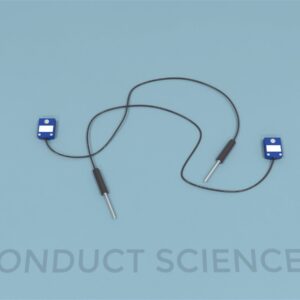The Rodent Pulse Oximeter employs user-friendly, non-invasive sensor clips for the seamless monitoring of rodents’ vital signs. This innovative device allows for the measurement of arterial oxygen saturation (SpO2), heart rate, breath rate, pulse distension, and temperature in both anesthetized and conscious animals.
Equipped with a variety of sensors, including options for the thigh, paw, collar, tail, and foot, the Rodent Pulse Oximeter ensures comprehensive and versatile monitoring. Easily attachable to the subject, the sensor clips facilitate convenient data retrieval and real-time monitoring on your PC.
ConductScience offers the Rodent Pulse Oximeter.

ConductScience is a company specializing in providing high-quality research equipment, lab supplies, and scientific services for the life sciences community.



The Rodent Pulse Oximeter is used to measure the vital signs of rodents non-invasively using sensor clips. Arterial oxygen saturation (SpO2), heart rate, breath rate, pulse distension, and temperature can be measured on anesthetized and conscious animals. The Rodent Pulse Oximeter is available with several sensors, including thigh, paw, collar, tail, and foot sensors. The sensor needs to be connected to the animal model and control box, and then the data is captured in real-time and displayed on the PC. It allows the vital signs measurement of up to 16 animals with heartbeats ranging from 90 to 900 beats per minute.
Pulse oximetry is the ability to constantly and transcutaneously measure the functional oxygen saturation of hemoglobin in arterial blood. It is used so frequently in healthcare that it is often regarded as the fifth vital sign (Chan, Chan, & Chan, 2013). The Rodent Pulse Oximeter allows SpO2 measurement in rodents, which can be used in animal models of diseases such as lung inflammation or injury. Moreover, it also provides measurements of other vital signs, broadening its range for other applications in respiratory, hypertension, neonatal, and brain injury studies.
The rodent pulse oximeter comes in a range of sizes, including XS, S, M, XL, and 2XL. Therefore, small animals of various sizes, including adult rats, neonatal mice, ferrets, and guinea pigs, can be accommodated. Apart from rodents, the Rodent Pulse Oximeter has also reliably measured the SpO2 in Andean goose waterfowl in a study by Ivy et al. (2018). The pulse oximeter is also MRI compatible, allowing rodents’ health to be monitored during MRI imaging using an MRI sensor.
Principle of Pulse Oximetry
Pulse oximeters work based on the principle that oxyhemoglobin (O2Hb) and HHb absorb red and near-infrared (IR) light differently. O2Hb absorbs more IR light and less red light than HHb and vice-versa. Pulse oximeters exploit this difference in O2Hb and HHb light absorption properties. They emit two wavelengths of light, red at 660 nm and near-IR at 940 nm, from a pair of small light-emitting diodes attached to the probe. The light passes through the subject’s body part where the probe is attached and is subsequently detected by a photodiode on the probe’s opposite side. Therefore, the pulse oximeter uses the red and IR light absorbed ratio to measure the quantity of Hb bound to oxygen (Chan, Chan, & Chan, 2013).
Specification | Value |
Heart Rate | 90-900 bpm |
Oxygen Saturation | 0-100% |
Pulse Distension | 0-800 µm |
Respiratory Rate | 25-450 brpm |
Breath Distension | 0-800 µm |
Body Temperature | 15-50 °C |
Our non-invasive pulse oximeter solution allows you to measure the following in conscious or unconscious in a range of animal models:. Measurements are taken every 0.72 seconds is displayed on the screen.
Connect the sensor to your animal model and control box, data is then taken in real-time and displayed on your PC.
Sensors In sizes XS, S, M, XL, 2XL available include:
The Rodent Pulse Oximeter utilizes simple, non-invasive sensor clips to monitor the vital signs of rodents. The sensor clips can be easily attached to the subject, and the data can be retrieved and monitored in real-time on your PC. The available sensors include thigh, paw, collar, tail, and foot sensors. The sensors have long longevity, and replacement is recommended after 100 hours of use, depending on the user.
It measures rodents’ heart rates with high accuracy of up to 900 BPM and breath rates up to 600 BrPM. It can be used on rodents of various sizes, including neonate mice to adult rats.
Apparatus Requirements
Accessories to match your pulse oximeter
Assessment of Lung Injury in Mice using the Rodent Pulse Oximeter
Lax, Wilson, Takata, and Thickett (2014) utilized the Rodent Pulse Oximeter to monitor lung function in murine models of lung injury. In addition, they compared oximetry readings with several lung inflammations and injury markers, including protein permeability index (PPI), the receptor for advanced glycation end products (RAGE), pulmonary neutrophils, and local cytokine expression. Male wild-type (WT) C57Bl/6 mice of 9 – 12 weeks of age were used in the study. Before taking pulse oximetry readings, the mice were briefly anesthetized using 5% isoflurane, and a collar clip sensor was placed. The mice were allowed to acclimatize for 5 minutes, and physiological readings were taken for 10 minutes on conscious, non-anesthetized mice. Following pulse oximetry measurement, the mice were exsanguinated to obtain the parameters indicating lung damage. The results indicated daily changes in arterial oxygen saturation and other cardiopulmonary parameters using pulse oximetry. A maximum decline in arterial oxygen saturation was observed at 96 hours post lung injury. The results from observation of lung inflammation and injury markers of murine lung injury revealed that blood oxygen levels negatively correlated with 7 of 10 quantitative markers. Therefore, the results identified pulse oximetry as a reliable non-invasive method for monitoring arterial oxygen saturation in rodents.
Investigation of Obesity-related Obstructive Sleep Apnea Syndrome (OSAS) in Obese Mice
Baum et al. (2018) investigated obesity-related OSAS in New Zealand Obese (NZO/HlLtJ) mice to examine whether they could be used as a pathophysiological model of OSAS. Sleep apnea events and sleep behavior of the mice were quantified. The Rodent Pulse Oximeter was used to measure pulsatile Saturation SpO2 using a collar sensor during the subject’s light/resting period. Additionally, polygraphic monitoring of sleep and awakening using electrodes, whole-body plethysmographs, ventilation, and polygraphic electroencephalogram, electrooculogram, and electromyogram (EEG, EOG, and EMG) states were also recorded for 24 hours. The results indicated that the NZO mice displayed larger numbers of spontaneous apnea and hypopnea events than the control mice. SpO2 results from the rodent pulse oximeter always displayed desaturation in the NZO mice, whereas normal saturation was observed in the control subjects. The tendency to sleep upright was also observed in the NZO subjects. The results hypothesize that the NZO mice’s defective upper airways and occasional inclination to sleep upright cause the sleep apnea/hypopnea events to be obstructive with periods of desaturation. Additionally, ventilatory abnormalities, sleep fragmentation, and sleepiness during activity periods was also observed in the NZO mice. Therefore, NZO mice may be a suitable pathophysiological model for OSAS since they share many characteristics with patients with OSAS.
Examination of Hypoxia Responses of the Andean Goose (Chloephaga melanoptera) using the Rodent Pulse Oximeter
Ivy et al. (2018) investigated whether the Rodent Pulse Oximeter can reliably measure SaO2 in Andean goose waterfowl. The animals’ hypoxia responses, including the heart rate and SaO2, were collected using the Rodent Pulse Oximeter. The results were compared with heart rate measurements using electrocardiography (ECG) from previously published data. Pulse oximetry neck collars were used to retrieve pulse oximetry measurements. The pulse oximetry collars and thin ECG electrodes were attached to the birds, who were cradled with their heads inside a 4-liter opaque box sealed around their necks.
The birds were then acclimatized for 60 – 90 minutes with ambient air flow having an O2 tension, PO2, of ~13.4 kPa. Following acclimatization, measurements began in ambient air for 25 minutes. Then a stepwise decrease of PO2 in the air flow was performed, which included 12, 9, 7, and 5 kPa, after which ambient airflow was returned, and the birds were allowed to recover for 25 minutes. The results indicated that the Andean geese’ responses to acute hypoxia exposure were relatively modest. The heart rate values obtained by ECG and those obtained using the Rodent Pulse Oximeter were highly concordant. Measurements of arterial O2 saturation made using a pulse oximeter were higher than those made using blood samples in earlier studies; however, surgery, cannulation, or other sources likely impacted the difference. Therefore, the Rodent Pulse Oximeter provides a reliable method for measuring arterial O2 saturation for high-altitude birds in the field without requiring invasive surgical procedures.
The Rodent Pulse Oximeter provides a non-invasive method for measuring rodents’ arterial oxygen saturation, heart rate, breath rate, pulse distension, and temperature. It is available with various sensor clips that can be attached to different parts of the rodent’s body, including the thigh, collar, tail, paw, and foot sensors. The vital sign measurements can readily be observed on a computer using USB plug-and-play technology that turns the computer into an affordable physiologic monitor. The Rodent Pulse Oximeter is available in different sizes, allowing it to be used in animals of various sizes. It can be used in translational studies to examine conditions such as lung injury and breathing disorders. The non-invasive procedure of the Rodent Pulse oximeter makes it useful not only for laboratory experiments but even for field experiments since the subjects don’t need to be surgically implanted with catheters for blood sampling.
| Brand | ConductScience |
|---|---|
| Sizes | 2XL, M, S, XL, XS |
| Species | Canine, Feline, Mouse, Rat, Rodent |
You must be logged in to post a review.
There are no questions yet. Be the first to ask a question about this product.
Monday – Friday
9 AM – 5 PM EST
DISCLAIMER: ConductScience and affiliate products are NOT designed for human consumption, testing, or clinical utilization. They are designed for pre-clinical utilization only. Customers purchasing apparatus for the purposes of scientific research or veterinary care affirm adherence to applicable regulatory bodies for the country in which their research or care is conducted.
Reviews
There are no reviews yet.